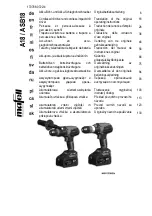
TROUBLESHOOTING
GRILL DOESN’T LIGHT
See the previous Troubleshooting tips for
checking the most common lighting issues.
LOW OR INSUFFICIENT HEAT
If you suspect that your appliance is NOT
providing the amount of heat that you
expect, there may be several things to look
at.
1. First, assure that you provide adequate
time for the food being prepared to heat
up. This process should be similar to and
exceed that amount of time you might
expect from your kitchen range.
2. Do not line ANY portion for the appliance
with aluminum foil. This will disrupt air flow
and cause the unit to burn unevenly.
3. Assure that the appliance is level. This
will also disrupt air flow and cause uneven
cooking.
4. Make sure that the gas type being used
(NG or LP) is the gas type that the grill was
set for at the factory. The label with this
information can be found on the right rear
of the appliance. If the gas type has been
converted (either at installation or at the
place of purchase) then check for the
following:
The Natural Gas (NG) unit has been
equipped with a gas regulator to be
installed at the rear. If this appliance has
been converted to Liquid Propane (LP), then
ensure that the original NG regulator has
been removed from the gas line grill before
the LP hose connection was added. Never
use more than one gas regulator to control
gas flow. This will substantially REDUCE
cooking efficiency.
5. If a low heat condition still persists, check
that the gas line (for NG applications) is of
adequate size for the length of run for all of
the equipment being used. The minimum
size is 1/2"(I.D.), but the larger 3/4"(I.D.)
size is recommended for optimum
performance. See section entitled
‘NATURAL GAS’ under the ‘GAS
CONNECTIONS’ portion of this manual.
6. If the gas used is Liquid Propane (LP),
check that the gas hose is not being
‘crimped’ and is connected to the tank
properly. The hose and regulator assembly
MUST be the hose that has been supplied
with your LazyMan appliance.
7. Low or insufficient heat can also be
caused by burner obstructions. Follow the
burner removal instructions found in the
section entitled ‘CLEANING THE BURNERS’.
With the burners out of the grill, look inside
each burner for obstructions that may
interrupt gas flow. Follow the remainder of
that section.
8. Windy conditions can greatly interrupt air
flow and cause insufficient heat conditions.
If heavy winds are prevailing and are
coming from any direction, it is better to
turn DOWN the heat on the burner.
Cooking may take a little longer, but the
smaller flames will not be as disrupted from
the wind as the larger flames.
YELLOW BURNER FLAMES-BIG 60 ONLY
1. A yellow flame from the burners
indicates a lack of air entering the burner.
This can also contribute to low or
27









































